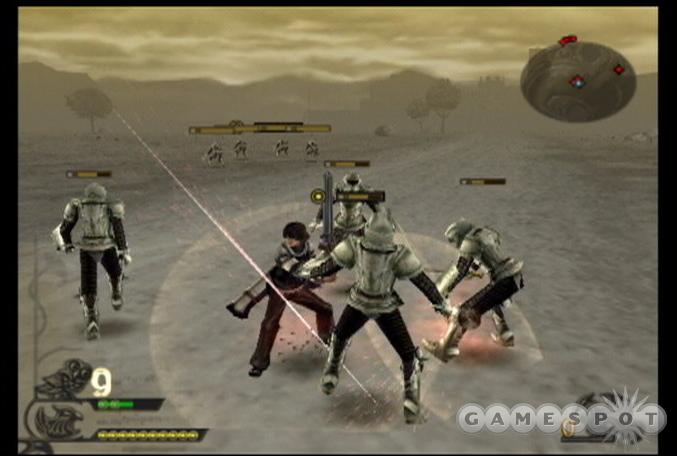Drakengard Preview
We check out the US version of Square Enix's unique action RPG.
Drakengard is the US version of Square Enix's Drag On Dragoon, which was a unique action RPG hybrid released in Japan last year that pulled a number of different game genres into one stylish package. The new game is being developed by up-and-coming Japanese studio Cavia, whose roster is composed of former members from several well-known teams, including Square Enix, Namco, and Sega. Although the unique title was well-received in Japan, the team has actually done quite a bit of work to polish it up for its stateside release. We recently had the chance to try out the US version of the game, and it looks promising.

Drakengard places you in the role of Caim, who is a young man on a quest to save the only family he has left--his sister Furiae. Game flashbacks give you the impression that the siblings' family tree was pruned pretty heavily when the pair was young. From the looks of the flashbacks, it appears as if young Caim watched as members of his family were chomped up by a dragon, which accounts for his spiky personality and explains why dragons don't thrill him. However, events in the game lead to some Odd Couple-style hijinks when Caim is mortally wounded and must form a pact with a red dragon, who, coincidentally enough, is also mortally wounded. By binding themselves to one another, the pair have the chance to live again. While Caim's quest to save his sister serves as the narrative's main drive, Drakengard's story is a dense narrative filled with complicated characters who are surprisingly dark. We feel safe in saying that some of the territory it covers has rarely been traveled in a US game before, so it should offer a disturbing and fresh experience for players. The tale unfolds via cutscenes, dialogue, and scripted events, which are spread out through 13 chapters.
Drakengard's gameplay complements the story with an engaging hybrid of different genres, all of which are folded into an action RPG. As mentioned, the game features 13 chapters that are broken up into subchapters. The chapters feature two distinct types of gameplay--ground and air combat. The ground combat is a moderately paced hack-and-slash in the same vein as Koei's Dynasty Warriors games, although some RPG elements have been included. You earn experience by hacking up the waves of foes that come at you, which lets you power up Caim's arsenal of weapons. While other games may purport to feature an "arsenal" of weapons for you to use, Drakengard doesn't mess around. You're eventually able to collect 64 weapons to use whenever you like, which provides a plentiful amount of options in your battles.

The flight segments are Panzer Dragoon-ish--right down to the lock-on system--although you're able to fly wherever you like. The shooting segments represent arcadelike changes of pace that are fun but challenging. Much like the ground combat, the flight segments feature an RPG twist, thanks to the ability to evolve your dragon into more powerful forms as you progress through the game. The flight segments also feature another cool twist in that you can switch from flying to ground combat ("on the fly") in many parts of the game, which lets you decide how you want to tackle an area.
The graphics in the game are stylized and have a unique look that works with the game's distinct art style. The human character models are detailed, although their animations are a bit stiff. The dragon, who is surprisingly spry for such a large beast, has moves that are more fluid than those of the humans. The environments are large and expansive, albeit a touch foggy in places. The game presents a nice array of effects for blood, and you can plan on seeing lots of it spilled over the course of your adventure. The game's frame rate stays solid and keeps the action running smoothly. The problematic camera found in the Japanese version has been tightened up, and while it's still not perfect, it's much improved.

The game's audio is a bit modest. However, an impressive collection of voice, music, and effects sell the experience. The voice acting is solid, for the most part, although there are a few voices that are a little off. The music tends to fit the action well and features a style that is appropriate for the game's overall look, thus presenting itself as one part classical and one part goth. The sound effects are a little understated, but they get the job done. We were actually hoping to hear some over-the-top hack-and-slash effects to go along with the copious amounts of blood that are spilled, but what can be found in the game works.
From what we've played so far, Drakengard is a unique game that pulls together a number of different elements. While the parts aren't especially amazing, the whole comes together nicely. The story is interesting, albeit disturbing, and ends up becoming a strong draw as you play. While all the leveling-up is good, you'll find that discovering just what's going on is a pretty strong motivator to get through the game. The inclusion of four endings also gives the game a nice chunk of replay value. Drakengard is currently slated to ship this March for the PlayStation 2. Be sure to look for more on the game in the coming weeks.
Got a news tip or want to contact us directly? Email news@gamespot.com
Join the conversation